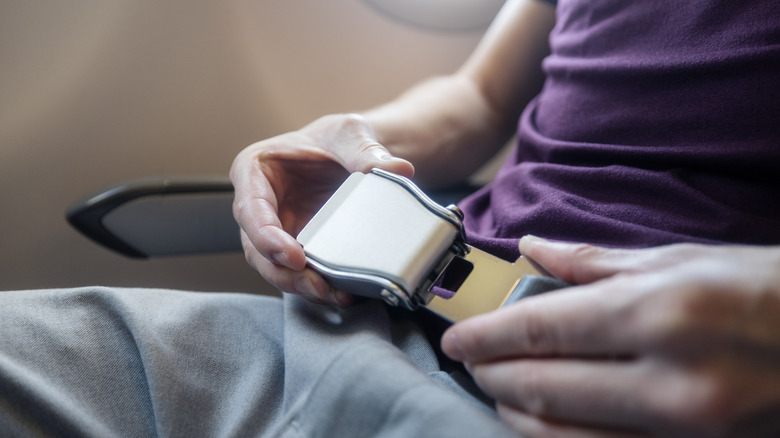The Most Important Thing To Do Before Falling Asleep On A Plane, Per Flight Attendants
Unless you need to get work done on a flight or are excited to watch an in-flight movie, the best way to kill time on a red-eye is definitely to sleep through it — but only if you wear your seat belt. Being in a cramped middle seat between two total strangers probably isn't the most comfortable or restful environment for sleeping, but that doesn't mean you should take off your seat belt before going to sleep. As alluring as that little bit of extra mobility may be, you should always nap with the belt securely buckled. Even though the fasten seat belt sign might be off when you're drifting away, it could go back on at any time.
Obviously, you'll need to unstrap periodically on long flights to go to the bathroom or allow your fellow passengers to get out of their seats, but as long as you're alert and strap in as soon as there are signs of turbulence, you can usually stay safe. However, if you're wearing your noise-canceling headphones and are curled up under a blanket, you won't notice that alert chime and the fasten seat belt flashing — so it's important that you have your seat belt on the whole time, just in case.
Why it's important to stay buckled in even when you're sleeping
While you probably already know that you shouldn't hop up and use the bathroom during a flight at the worst times (when the fasten seat belt sign is on), you don't want to get caught snoozing in your seat without your seat belt during turbulence, either. While it might not seem like a big deal, in-flight turbulence can be serious. If you're fast asleep when there's severe turbulence or worse, an unexpected flight emergency, and you're unaware that you should be buckled up, you could get hurt.
While we've become very accustomed to mild turbulence (especially as flights seem to keep feeling bumpier and bumpier), it's important to remember that it can be dangerous. While turbulence is extremely unlikely to cause a plane to crash, around 12 people every year are injured during turbulence. This is part of the reason why flight attendants (especially those working long-haul flights) never fall asleep on a plane without their seat belts on. If you're strapped in, there's very little risk of injury, but if your belt is off, an unexpected bump might cause you to lift out of your seat and knock your head on the overhead bins.
How to sleep comfortably on flights even when you're strapped in
You might feel restricted by your seat belt on planes, but you'll need to keep it on while you sleep for safety. Fortunately, there are other things you can do to feel comfortable enough to get some rest while you're in the air. For example, some game changers include coming prepared by wearing comfortable clothes (preferably including a sweatshirt to take on and off as the temperature fluctuates), putting on an eye mask, and supporting your head and neck with a cozy neck pillow.
If the reason that you prefer to unbuckle your seat belt to sleep is because it's uncomfortably tight even when loosened, you may need to ask for a seat belt extender. Under the FAA, airlines are required to provide them to passengers who ask, and they will not charge you extra to borrow one. Once your seat belt is clipped on and secured, you can safely sleep through your flight.


